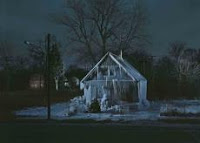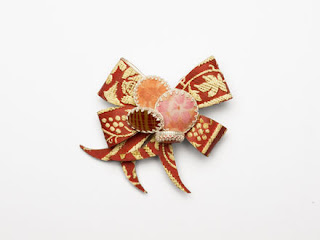





 This week we had a visitor, a Moving Image tutor and graduated filmmaker Eldon Booth who shared to the class a bit about his works as a filmmaker. One of his methods he explains is his use of facts and fiction within his films, portraying families real-life photographs into a fiction story and interviews in an untrue documentary style film.
This week we had a visitor, a Moving Image tutor and graduated filmmaker Eldon Booth who shared to the class a bit about his works as a filmmaker. One of his methods he explains is his use of facts and fiction within his films, portraying families real-life photographs into a fiction story and interviews in an untrue documentary style film.

Eldon mention he got hold of his friend private family albums and was aloud by the family to put them into fiction film story. That's struck me with surprise because the privacy and precious photo-album are and the history content it holds for a family. I wouldn't ask or accept my friends photograph albums because of the history and events the photograph albums have. Eldon transforms these historic and memorable events into a fiction film content. I personally found offensive and disrespectful to his friend family even if he got the family consent because of the public viewing of sum films may upset the family and audiences.http://www.eldonbooth.com/


I found on a couple of true story films on the net that blurs the lines of fiction or facts but Sir Peter Jackson "Heavenly Creature" in 1994 movie, was based on the 1954 Parker/Hulmer murder case was the film that had a lot of real-life contents.The setting and location of the film were the location of the actual events and the selection of the cast were chosen primarily of their physical resemblance to the real-life characters.

Another mix of facts on the film was the scene of Pauline's room has a real picture of Juliet Hulme on the wall and all of voice over dialogue are truthful and directly from the real-life Pauline Parker Diary entries that Jackson used for the film and its the most truthful information he grasp about the Pauline Parker and Juliet Hulmer relationship.
The movie "Elephant" by Gus Van Sant has a mix of facts and fiction. The lighting and sound in the movie gives a realistic feeling and noise with less editing between shots because of the continuity footage with diegetic sound within the setting and location with barely any extra diegetic sound. After looking into the movie a bit more, I found that most of the cast are non-actors and were actual using their real names. In relation to Booth films, The cast in his films are mostly non actors with an exception, his main character. He gave advice about non actors quote "Do not give them much info" stating that its easier to explain by frame.
EXTRA: The film is based on the Columbine High School Massacre. As I watched the film on Thursday, the film remind me of a similar documentary I watched about 2 years ago that I couldn't recalled. As I research into the movie more, I found out that in 2005, three years after the movie was released. The Red Lake High School Massacre was heavily influenced and blamed on the film and the murderer Jeff Weise watched the film 17 days prior to the shooting and according to a friend of Weise, his favorite scene of the film was massacre scene. Some graphic violence in films are at times the pushing factor within someone and is influential in many ways, good or bad.
http://www.youtube.com/watch?v=EZ_yluDQcMA&feature=related Alex and Eric Massacre scene
http://news.bbc.co.uk/2/hi/americas/4382087.stm
Today our class had another seminar with fellow lecturer and video installation artist Leilani Kake. They were two things about Kake works that interest me the most was her idea around identity and personality. Her works deals with ethnicity, culture and spirituality that are real factors behind all her work. I took note on her inspiration brainstorm and wanted to find out more about this people. She explained that she chose this specific people because of the concepts, ideas, techniques and personal issues her inspirational people possess.

Kake draws inspiration from Merata Mita, an important figure in the progression of Maori in the NZ film industry. Mita has been around the industry for 30 years was the director behind the documentary film "1981 Springbok Tour of New Zealand" an important moment in NZ history of racial discrimination. She was also the first Maori women to write, direct and produce a film in NZ history with the 1988 Mauri. She referred to her mother, as one of her inspiration was great and identical to myself as I too see my mother as an inspiration behind my life and art. My thriving for success in art is all thanks to my mother who supported my change in personality from rugby to art and is a reason why I'm do something with art to make her proud.
 I think Kake use the "Kia Ora" to bring the relationship between Maori and Cook Island closer and how closely related these two cultures are through art. Kake simple text of "Kia Ora" throughout her video is manipulating in size, width, length, mirroring, overlapping and repetition. These techniques that she has used on a simple text create patterns and shapes that are identical and relevant to the Pacific Island art patterns linking Maori culture to its very root of being in one with Polynesia.
I think Kake use the "Kia Ora" to bring the relationship between Maori and Cook Island closer and how closely related these two cultures are through art. Kake simple text of "Kia Ora" throughout her video is manipulating in size, width, length, mirroring, overlapping and repetition. These techniques that she has used on a simple text create patterns and shapes that are identical and relevant to the Pacific Island art patterns linking Maori culture to its very root of being in one with Polynesia. http://ngahauewha.wordpress.com/artist-curator/

The "Rapid Change" exhibition @ the Te Tuhi Art Gallery in Pakuranga was very interesting and heart felting because the politics and society issues that impact on the urban household in specific cities around the globe. One work that was interesting was Gregory Holm & Matthew Radune "Ice House Detroit"(2010). A Photographer and Architect collaboration work dealing with the Detroit urban society problem with unemployment, debts and Unpaid mortgages due to the never stoping recession. Holm and Radune contribution work has gained local and global interest through the media and the art world. The chilled ice house was specifically staged and build around a suburban to symbolize homeowners house lost and wanted to help those homeless with their funding they got through the media coverage of their artwork.
http://www.tetuhi.org.nz/exhibitions/exhibitiondetails.php?id=100
 On thursday the class had a special guest speaker, a tutor and practitioner jeweler Mary Curtis. Although I was late for her seminar I was able to get some notes down about herself and work. One thing That I took notice about her discussion was the importance of presentation and composition and something to be taken very seriously. Till now I didn't really payed attention to the presentation and composition until Curtis talk, It's now become an important aspect to me as an art student.
On thursday the class had a special guest speaker, a tutor and practitioner jeweler Mary Curtis. Although I was late for her seminar I was able to get some notes down about herself and work. One thing That I took notice about her discussion was the importance of presentation and composition and something to be taken very seriously. Till now I didn't really payed attention to the presentation and composition until Curtis talk, It's now become an important aspect to me as an art student.